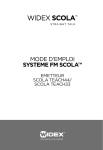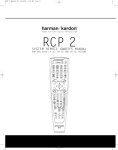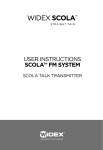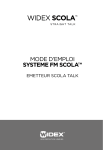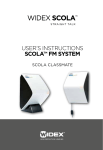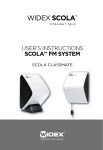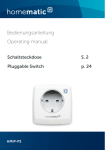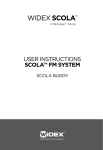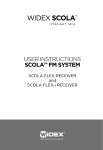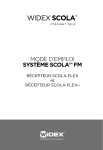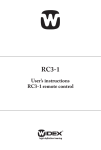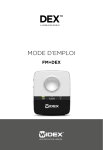Download Widex Scola Technical information
Transcript
User instructions SCOLA™ FM system SCOLA TEACH44/ SCOLA TEACH33 transmitter 2 Contents SYMBOLS . . . . . . . . . . . . . . . . . . . . . . . . . . . . . . . . . . . . . . . . . . . . . . 4 INTRODUCTION . . . . . . . . . . . . . . . . . . . . . . . . . . . . . . . . . . . . . . . . . 5 THE SCOLA™ FM SYSTEM . . . . . . . . . . . . . . . . . . . . . . . . . . . . . . . . . 6 DESCRIPTION . . . . . . . . . . . . . . . . . . . . . . . . . . . . . . . . . . . . . . . . . . 9 PREPARING THE SCOLA TEACH . . . . . . . . . . . . . . . . . . . . . . . . . . 13 Inserting the battery . . . . . . . . . . . . . . . . . . . . . . . . . . . . . . . . . . . 13 Charging . . . . . . . . . . . . . . . . . . . . . . . . . . . . . . . . . . . . . . . . . . . . . 13 Connecting the microphone . . . . . . . . . . . . . . . . . . . . . . . . . . . . . 14 Positioning . . . . . . . . . . . . . . . . . . . . . . . . . . . . . . . . . . . . . . . . . . . . 15 OPERATING THE SCOLA FM SYSTEM . . . . . . . . . . . . . . . . . . . . . . 16 On/off . . . . . . . . . . . . . . . . . . . . . . . . . . . . . . . . . . . . . . . . . . . . . . . 16 Channel selection . . . . . . . . . . . . . . . . . . . . . . . . . . . . . . . . . . . . . . 16 Synchronising SCOLA FLEX or SCOLA buddy . . . . . . . . . . . . . 17 Microphone on/off . . . . . . . . . . . . . . . . . . . . . . . . . . . . . . . . . . . . . 18 Keypad lock . . . . . . . . . . . . . . . . . . . . . . . . . . . . . . . . . . . . . . . . . . . 18 Connecting audio equipment . . . . . . . . . . . . . . . . . . . . . . . . . . . . 18 Battery and charging . . . . . . . . . . . . . . . . . . . . . . . . . . . . . . . . . . 19 Team Teaching function . . . . . . . . . . . . . . . . . . . . . . . . . . . . . . . . 20 Table with SCOLA TEACH key functions . . . . . . . . . . . . . . . . . . 22 GOOD ADVICE . . . . . . . . . . . . . . . . . . . . . . . . . . . . . . . . . . . . . . . . . 23 CARE AND MAINTENANCE . . . . . . . . . . . . . . . . . . . . . . . . . . . . . . 25 WARNINGS . . . . . . . . . . . . . . . . . . . . . . . . . . . . . . . . . . . . . . . . . . . . 26 IN CASE OF MALFUNCTION . . . . . . . . . . . . . . . . . . . . . . . . . . . . . . 27 TERMS AND DEFINITIONS EXPLAINED . . . . . . . . . . . . . . . . . . . . 31 WARRANTY . . . . . . . . . . . . . . . . . . . . . . . . . . . . . . . . . . . . . . . . . . . 42 REGULATORY INFORMATION . . . . . . . . . . . . . . . . . . . . . . . . . . . . 43 3 SYMBOLS The following symbols will be used throughout the manual: WARNING Messages with this heading indicate adverse reactions, potential safety hazards or inadequate device performance. CAUTION Messages with this heading indicate/include information regarding any special care to be exercised. Not for general waste 4 INTRODUCTION SCOLA provides hearing aid users with additional opportunities in difficult listening situations. The SCOLA FM system has been developed specifically for children and educational environments. These instructions therefore primarily address parents and teachers. The symbol refers to the section ‘Terms and definitions explained’, where you will find detailed explanations of functions and technical terms. WARNING This booklet contains important information and instructions. Read this booklet carefully before you start using the device. Note Your SCOLA TEACH device and accessories may not look exactly as illustrated in this booklet. We furthermore reserve the right to make any changes considered necessary. 5 THE SCOLA™ FM SYSTEM The SCOLA™ FM system consists of a SCOLA TEACH transmitter and one or two SCOLA receivers. The SCOLA TEACH transmitter’s primary function is to transmit sound signals from the microphone or audio equipment to the SCOLA receiver(s). The operating range is up to 20-30 metres, depending on the surroundings. The transmission power is very low and limited by national regulations. It has no physiological side effects. SCOLA TEACH is available in two versions: SCOLA TEACH44 with the Team Teaching function, and SCOLA TEACH33 without the Team Teaching function. The Team Teaching version can easily be recognised by its key on the keypad. The SCOLA TEACH transmitter and SCOLA receiver(s) must be on the same channel in order to work together. 6 SCOLA TEACH with standard accessories SCOLA TEACH (The version shown is the Team Teaching version) Lapel microphone (omnidirectional) including neck cord and clips Charger 7 Rechargeable battery Audio lead Storage case User instructions s ction teM instrU UserLA™ FM SyS / SCO eAch44 eAch33 scoLAt r itte scoLAt trAnsm 8 DESCRIPTION The top of SCOLA TEACH has the following functions: Light-emitting diode indicator (LED) On/off button (which also serves to turn the microphone on or off) Microphone jack (2.5 mm jack) The front of SCOLA TEACH has the following functions: Display with: Status bar Battery indicator Channel Tracer Team Teaching Keypad lock Microphone 9 Channel information H02 15 NOTE The corresponding channel number for MicroLink FM equipment is shown at the bottom of the display 10 Multifunctional keypad (this illustration shows the Team Teaching version) Team Teaching key ©C key, which serves as an undo key, amongst other things Arrow keys OK key The bottom of SCOLA TEACH has the following functions: Jack (3.5 mm) for connection of an external sound source or headset Jack for connection of charger (mini USB jack) 11 The back of SCOLA TEACH has the following functions: Belt clips for fastening the SCOLA TEACH Battery cover NOTE The approval label with serial number is located below the battery. We recommend that you make a note of the serial number at the back of this booklet. 12 PREPARING THE SCOLA TEACH Inserting the battery Remove the battery cover and insert the battery provided . Be sure to insert the battery correctly, with the positive pole oriented as illustrated. Charging The battery included is not charged. Before the battery is used for the first time, it must be charged for at least 14 hours. With the charger plugged into the socket, connect the charger to the SCOLA TEACH as illustrated. 13 During charging the battery symbol will be shown in the display and the LED will be red. Battery charging! NOTE The transmitting function is off during charging. Connecting the microphone Plug the microphone lead into the microphone jack. The microphone lead serves as an antenna . For optimum operating range , make sure that the lead hangs as freely as possible. The standard version of the microphone is omnidirectional, which means that it picks up sound equally from all directions. 14 Positioning SCOLA TEACH can be placed in a pocket or clipped onto a belt. The microphone can be clipped onto clothes or hung around the neck on the neck cord. The standard microphone can also be replaced by one of the other microphones available as optional accessories. 15 OPERATING THE SCOLA FM SYSTEM On/off Press and hold down the on/off key on SCOLA TEACH for one second until the LED is green. The user’s name or ”WIDEX SCOLA” will appear on the display for approx. two seconds. SCOLA TEACH is turned off by holding the on/off key down for one second. Channel selection When SCOLA TEACH is turned on, the starting channel will usually be the channel last used, unless programmed differently. To select another channel : Hold down the or key. H02 15 will appear in front of the channel number. Press or until the required channel number appears, and press . Press C if you wish to exit without changes. 16 NOTE Note that interference may occur if other transmitters are using the same channel as you. Synchronising SCOLA FLEX or SCOLA BUDDY If the receiving channel differs from the transmitting channel of SCOLA TEACH, the former can be synchronised to the latter. Press briefly. If there are one or more SCOLA receivers within a range of approx. 80 cm, the receiving channel will be synchronised to the transmitting channel (standard synchronisation ). When the SCOLA receiver picks up the synchronisation signal, the user will hear a beep, confirming the connection, even if the receiving channel has not been changed. The option of extended synchronisation (teacher’s synchronisation ) is also available. 17 Microphone on/off The microphone can be turned on and off by pressing the on/off key briefly. A green light will flash in the LED and the following symbol will blink in the status bar: Keypad lock The keypad can be locked and unlocked by holding down the right and left arrow keys simultaneously. Any attempt to activate a locked key will result in the following message: ! + The hearing care professional can program the keypad to lock automatically if 1½ minutes have elapsed without any key press. Key lock is active. Hold down to unlock. Connecting audio equipment SCOLA TEACH can be connected to audio equipment (radio, TV, DVD, PC, etc.) with the audio lead provided. Connect the lead from the audio input jack of SCOLA TEACH to the headphone jack of the audio equipment. The sound signal volume is usually adjusted using the volume control of the audio equipment. 18 The microphone should also be connected, as its lead serves as an antenna. When the microphone is turned on, it is possible to speak over the sound from the audio equipment. When the microphone is turned off, only the sound from the audio equipment will be heard. If the jack does not fit your audio equipment, a lead with phono plugs and/or a SCART plug can be acquired as an extra accessory. Battery and charging One AA battery is required for SCOLA TEACH. A rechargeable nickel-metal-hydride (NiMH) battery is included as a standard accessory. Ordinary non-rechargeable batteries can also be used, in which case we recommend the alkaline type. After its first charge, the battery charge time is ten hours, providing power for approximately ten hours of use. Battery status is indicated by the battery symbol in the display. We recommend that you always have a spare battery with you in case the rechargeable battery becomes drained. 19 T Team teaching 13 TT Ch: 55 H02 H06 T Team teaching 13 H01 TT Ch: 30! H Team Teaching function The Team Teaching function is available only in the SCOLA TEACH version provided with a key. The Team Teaching function is activated by holding down the key. The symbol appears in the display status bar, and the transmitting channel and Team Teaching channel (TT Ch) are displayed. SCOLA TEACH automatically calculates the risk of interference between the transmitting and receiving channel. If there is a risk of interference, the Team Teaching channel will be grey, followed by an exclamation mark. The Team Teaching function is deactivated by holding down C or . Team Teaching channel selection: The TT channel is changed in the same way as the transmitting channel. 20 Press and hold down the or key. Then press again to go to another TT channel. Pressing will allow you to change the transmitting channel and still maintain the TT channel. Try to find channels that are not grey. To exit with changes, press . To exit without changes, press C. 21 Table with SCOLA TEACH key functions Hold down (1 second) Press On/off key On/off Microphone on/off. or Enable channel change Enable TT channel change with the TT function active*) Channel change or Switch between transmitting and TT channel with the TT function active*) + simultaneously Lock / unlock keypad + simultaneously Rotate display ”OK” key *) C Teacher’s synchronisation Exit with changes after channel change Channel synchronisation Activate/deactivate TT function*) Deactivate TT function*) Exit without changes *) Applies only to the SCOLA TEACH version with Team Teaching function. 22 GOOD ADVICE SCOLA TEACH is primarily intended for educational environments, but can also be used in other situations where noise, poor acoustics or the like make listening difficult. To benefit fully from the SCOLA FM system, it is important to: • practise using the FM system and test the different settings in familiar surroundings • inform other people that you use an FM system with your hearing aid, so that they can understand why they should talk into the microphone, and how the system works • select the right settings for SCOLA TEACH and the SCOLA receiver(s) 23 Listening situation Use of SCOLA TEACH and microphone positioning In kindergartens / classrooms Ask the teacher to use SCOLA TEACH and position the microphone as described. Microphone types other than omnidirectional are available as optional accessories to optimise the speech signal. For group work, or if several teachers are present, we recommend the use of the Team Teaching function. This requires that SCOLA TEACH is provided with this function, and that an extra FM microphone is available. Lectures Check that there is no interference on the channel selected for the system. Find and select a noisefree channel for the transmitter and receiver. Explain to the lecturer how SCOLA TEACH works. Ask the lecturer to keep the microphone as close as possible to his or her mouth. At home Using the FM system at home is almost the same as in the classroom. SCOLA TEACH can be connected to the TV, PC, etc. via the audio lead. With a Team Teaching version transmitter and an extra FM microphone, e.g. a SCOLA TALK, both parents can communicate with their child via FM. In the car The SCOLA FM system is particularly effective in a car. The microphone should be placed as closely as possible to the person speaking. It is possible to listen to music from an MP3 player or the like by connecting the audio lead from the SCOLA TEACH to the headphone jack of the MP3 player. Leaving the microphone on allows the child to hear music as well as any speech into the microphone. 24 CARE AND MAINTENANCE In general, the SCOLA™ FM system should be cared for in the same way as the hearing aid. It is a good idea to clean and remove dirt and debris from the FM system on a daily basis. There are also some special precautions which should be taken. • Remove any dirt from SCOLA TEACH with a dry, soft cloth. • Do not disassemble any of the SCOLA products or hearing aid, as this will void the guarantee. • Do not use water, alcohol or the like to clean the FM system. • Make sure that the microphone, audio and charger cords do not become tangled up. • Do not expose the SCOLA FM system to cosmetics, hair spray, water, cleaning solutions or other chemicals. 25 WARNINGS Warning •Make sure that the batteries for the hearing aid and for the SCOLA TEACH are kept out of reach of children, who might place them in their mouths. •Discard used batteries carefully. •Do not change batteries in front of children, and do not let them see where you keep your supply. 26 IN CASE OF MALFUNCTION With proper use and maintenance, your SCOLA™ FM system will give you years of reliable service. The following pages contain some brief advice to follow if you experience problems with your SCOLA FM system. Before contacting the hearing care professional where you acquired your SCOLA FM system, please follow the advice below: If there is no sound from the SCOLA FM system or the audio equipment, or the sound is distorted, it could be because: • The hearing aid, SCOLA TEACH or the SCOLA receiver(s) are not set correctly. Check to ensure that all the settings are correct for the desired use, and that both the transmitter and receiver are turned on. • SCOLA TEACH and the SCOLA receiver(s) are not set to the same channel. Check that the channel number in the display of the SCOLA TEACH is the same as the receiving channel of the SCOLA receiver by performing a channel synchronisation. 27 If there is noise in the hearing aid, it could be because: • You are at or beyond the limit of the operating range of SCOLA TEACH. Reduce the distance between the SCOLA TEACH and SCOLA receiver. • Noise and whistling are interfering with reception, possibly because two or more FM transmitters are transmitting on the same channel as your receiving channel. To avoid this type of interference, make sure that only one FM transmitter is transmitting on the receiving channel. Try turning off your SCOLA TEACH. If you hear another FM signal, this is what is causing the noise. There are several ways of avoiding interference: • Turn on one FM transmitter only. • Find another available channel and select this channel on both SCOLA TEACH and the SCOLA receiver. • Increase the distance between the interfering FM transmitter until the interference stops. 28 If there is no sound from the audio equipment, but the sound from the SCOLA TEACH microphone signal is okay, it could be because: • The audio lead is not correctly plugged into the audio jack on the SCOLA TEACH or audio equipment. Check that it is correctly plugged in. • The signal from the audio equipment is too weak. Turn up the volume of the sound signal on the audio equipment’s volume control, if possible. If the battery is quickly drained of power even after a full charge cycle, but the display indicates that the battery is charged, it could be because: • The battery is defective. Contact the hearing care professional where the SCOLA FM system was acquired, to have the battery changed. You can use standard alkaline (nonrechargeable) batteries until this is done. 29 If the battery does not charge and the display does not indicate that the battery is charging, it could be because: • There is no power in the socket. Check that the socket functions. • The charger lead or jack is defective. Consult the hearing care professional where the SCOLA FM system was acquired. • The connecting terminals on the battery are dirty or defective. Consult the hearing care professional where the SCOLA FM system was acquired. warning Low battery can cause the sound transmission to suddenly stop. 30 TERMS AND DEFINITIONS EXPLAINED Antenna The receiver and transmitter are both provided with an antenna. The microphone lead of SCOLA TEACH also serves as an antenna, and should therefore always be connected, even when only the audio input function is being used. Turn off the microphone if the microphone signal causes disturbance. Approval and CE marking SCOLA TEACH and the SCOLA receiver have been tested at an EU/FCC accredited test laboratory. The CE/ FCC marking and declaration of conformity document that the products conform to the directives and technical requirements laid down in North America and the EU, as well as in associated countries. The transmitter and receiver are provided with serial numbers. 31 Battery - SCOLA TEACH One AA battery is required for SCOLA TEACH. The rechargeable battery included is a nickel-metal-hydride (NiMH) type battery. It is environmentally friendly and does not contain heavy metals. The contact surface at the negative pole ensures that only this type of battery can be charged in SCOLA TEACH. The lifetime of the battery depends on the number of times it is charged. If the battery is charged daily, we recommend changing the battery once a year to ensure optimum operating time. Other battery types can also be used, but cannot be recharged. 32 warning If you use other types of rechargeable batteries in SCOLA TEACH than the original, it must be charged in a separate charger. If you use a NON-rechargeable battery, then use only high quality batteries, e.g. alkaline batteries. Always remove exhausted alkaline batteries from the battery compartment to limit the risk of leakage. If you try to charge alkaline batteries or other NON-rechargeable batteries or other rechargeable batteries than the type included with SCOLA TEACH, all that will happen is that the display will show: “WARNING, the battery is not rechargeable”. Rechargeable batteries cannot be overcharged in SCOLA TEACH. ALWAYS remember to remove the battery – irrespective of type – if the transmitter will not be used again soon. If you have any questions about the type, acquisition, use or disposal of batteries, please consult the hearing care professional where you acquired your SCOLA™ FM system. CAUTION Batteries that are no longer usable should be disposed of in accordance with applicable environmental requirements. 33 Battery charging Fully charging a drained battery takes ten hours. Before the battery is used for the first time, we recommend that it is charged for 14 hours. Even when the battery is fully charged, the battery symbol will continue to indicate that the battery is charging for as long as the charger is connected. The battery cannot be overcharged. warning Charger and mini USB connector: This device can be charged by an external charger or USB device. Only connect a charger that is compatible with the SCOLA TEACH. The charger plug and input rating must be compatible with the AC wall outlet in your region. When the SCOLA TEACH is connected to external mains-operated equipment like a charger or PC or similar, this equipment must comply with IEC 60065, IEC 60950, IEC 60601-1 or equivalent safety standards. Widex strongly recommends that you always use a charger that is supplied by your Widex distributor to ensure safe and efficient use of your SCOLA TEACH. Battery status The battery power level is shown in the display. Five bars indicate that the battery is fully charged, three bars that it is half charged, and no bars that it is almost drained (less than ½ hour of operation remaining). 34 When the battery is almost drained, the battery symbol flashes in the display and the LED flashes red. After a while, the transmitter will turn off. If the receiver is connected, this can be clearly heard in the hearing aid. For optimum battery lifetime, we recommend not recharging the battery until the battery indication is below two bars. Channels and frequencies SCOLA TEACH can be set to transmit on different channels. Each channel corresponds to a specific frequency. Only channels/frequencies that are permitted in the country where the transmitter is employed may be used. SCOLA TEACH is pre-programmed with the channels permitted in the country where it is acquired. The channel numbers are divided into three frequency bands indicated by “H”, “J” or “N” in the lower left-hand corner of the display. The corresponding channel number for MicroLink equipment is displayed after these three letters. This is an advantage if several FM systems are used simultaneously. 35 SCOLA TEACH can transmit sound signals on most permitted frequencies in the frequency ranges 169 MHz– 176 MHz (H band), 180 MHz-187 MHz (J band) and 216 MHz-217 MHz (N band). note •Do not use two transmitters (e.g. SCOLA TEACH) on the same channel/frequency in the same area. •Note that there is a risk of interference from other radio communications, especially when using the system abroad. •Please note that when travelling abroad it may not be permitted to use the same channels as in your own country. Channel synchronisation The SCOLA TEACH transmitting channel can be synchronised with the SCOLA receiver’s receiving channel in two ways. Standard synchronisation Press once. This will change the receiving channel to the same one as the transmitting channel. For this type of synchronisation, the distance between the SCOLA TEACH and SCOLA FLEX or SCOLA buddy should be approximately 10-80 cm. The FM user will hear a beep tone when synchronisation is complete. 36 Teacher’s settings and Teacher’s synchronisation The SCOLA TEACH transmitter can wirelessly synchronise SCOLA FLEX with what we call the Teacher’s settings. These Teacher’s settings are temporary, and can only be reset by switching the hearing aid off and on. The purpose of this is to prevent small children from operating the mode switch and scan button on the SCOLA FLEX receiver during classes. These settings can be activated without any risk of altering the settings entered by the hearing healthcare professional. To set up the Teacher’s settings: Access “Teacher’s menu” by pressing the C key and the key simultaneously. Press to select “Sync Settings”. With the arrow keys, select switch and scan button settings and press . Leave “Teacher’s menu” by pressing C. To perform a Teacher’s synchronisation: From the standard “user mode”, hold down for about 1 sec. This will synchronise the receiving channel with 37 the transmitting channel, mode switch and scan button settings. When a Teacher’s synchronisation is performed within the reply range of 10 to 30 cm, the settings of the SCOLA FLEX will be shown in the SCOLA TEACH display. If a Teacher’s synchronisation is performed at a distance of approximately 30 cm-80 cm, the teacher’s synchronisation will still take place, and a beep-tone will be heard in the hearing aid. However, the SCOLA TEACH display will indicate that the receiver is outside its reply range, and it will not show the detailed settings. note The optimal operating range is achieved by holding the SCOLA TEACH vertically – NOT horizontally, as you might with an ordinary remote control. FM system An FM system is a radio communication system in which a transmitter sends signals to a receiver via carrier waves. ”FM” stands for “frequency modulation” and is a technical term for the way in which the radio signal is produced. FM transmission ensures high quality reception without any noise, hum or distortion. 38 If you have two hearing aids, they should both have a receiver. note Do not use SCOLA on aircraft or in hospitals without permission. Interference Interference occurs when signals from two transmitters on the same frequency are mixed in the same receiver. When the signals are equally strong, the interference will be most noticeable. The further away one transmitter is from the receiver compared to the other transmitter, the weaker the disturbing noise will be. Interference can be avoided by selecting another transmitting and receiving channel. Any potential risk of interference may be detected if the Channel Tracer function is active. Channel Tracer is a function in the Teacher’s menu. Consult your hearing care professional for further information. 39 Microphones for SCOLA TEACH Omnidirectional lapel microphone: Standard microphone included with SCOLA TEACH. The microphone is equally sensitive to sound from all directions. The following microphones are available as optional accessories: Directional lapel microphone: Designed for noisy environments; more sensitive to sounds from one direction. Lavalier microphone: Hangs around the neck along with the SCOLA TEACH. The lavalier microphone lead also serves as an antenna. When hung around the neck, the SCOLA TEACH display is upside down. Press simultaneously to rotate the display and keys 180 degrees. Headset microphone: Designed for especially noisy environments. It should be placed 2-3 cm from the mouth of the speaker. The advantage of this microphone type is that its signal remains unchanged even if the person speaking turns his or her head. All microphones for SCOLA TEACH are provided with a 2.5 mm jack. 40 Operating range The operating range of the FM system is highly dependent on the surroundings, including construction materials. The optimum operating range of 20-30 metres can be obtained in the open and with the microphone lead hanging freely. Inside buildings with steel and concrete walls and floors, the operating range may be reduced to ten metres. The position of the SCOLA receiver will also affect the range. caution Note that what is being transmitted from SCOLA TEACH may possibly be picked up by another FM system. Phono / SCART plugs If the 3.5 mm jack of the audio lead does not fit the audio equipment, an additional lead should be acquired. Phono plugs are widely used with CD players, stereo systems, etc., and a SCART plug can be used with television sets or video equipment provided with a SCART connection. Connect the leads and plugs in the following way: Audio lead <-> lead with phono/SCART plugs <-> SCART connection. 41 WARNING Audio connector (3.5 mm jack): The safety of the use of SCOLA TEACH is determined by any external equipment that is connected to the SCOLA TEACH via the audio connector. When SCOLA TEACH is connected to external mains-operated equipment via the audio connector, this equipment must comply with IEC60065, IEC60950, IEC 606011 or equivalent safety standards. Team Teaching function (SCOLA TEACH with Team Teaching only) When the Team Teaching function is active, the signal from the team microphone (an extra FM microphone such as SCOLA TALK) will be relayed to one or more SCOLA receivers along with the microphone signal from SCOLA TEACH. This allows two persons, e.g. two parents or teachers, to be in contact with one or several FM users at the same time. With the team microphone’s audio input connected to a TV or audio equipment, the sound signal is sent wirelessly to the student, who can simultaneously hear what the teacher is saying. 42 Additional technical information: SCOLA TEACH has a built-in FM receiver which enables Team Teaching. The channel used for the receiver and the team microphone must be the same. This channel can be selected in the Team Teaching menu. Reception on the Team Teaching channel is only possible if the frequency distance between the SCOLA TEACH transmitting channel and the Team Teaching receiving channel is sufficiently large. This distance is calculated by a program integrated in SCOLA TEACH. If the frequency distance is too small, the Team Teaching channel number will have a grey appearance with an exclamation mark, indicating that there is a risk of interference . If the channel for the team microphone cannot be changed, another transmitting channel can be selected until the warning disappears. 43 WARRANTY A warranty of two years is provided. The warranty covers any defects in manufacture or materials. Defects arising from improper handling or repairs carried out by an unauthorised party are not covered by this warranty. 44 REGULATORY INFORMATION WIDEX A/S • Nymoellevej 6, DK-3540 Lynge Denmark • www.widexusa.com Hereby, Widex A/S declares that this SCOLA TEACH44 and SCOLA TEACH33 are in compliance with the essential requirements and other relevant provisions of Directive 1999/5/EC. A copy of the Declaration of Conformity can be found at http://www.widex.com 45 FCC ID: U28AT31 IC: 5676B-STE Federal Communications Commission Statement This device complies with part 15 of the FCC Rules. Operation is subject to the following two conditions: (1) This device may not cause harmful interference, and (2) this device must accept any interference received, including interference that may cause undesired operation. NOTE: This equipment has been tested and found to comply with the limits for a Class B digital device, pursuant to part 15 of the FCC Rules. These limits are designed to provide reasonable protection against harmful interference in a residential installation. This equipment generates, uses and can radiate radio frequency energy and, if not installed and used in accordance with the instructions, may cause harmful interference to radio communications. However, there is no guarantee that interference will not occur in a particular installation. If this equipment does cause harmful interference to radio or television reception, which can be determined by turning the equipment off and on, the user is encouraged to try to correct the interference by one or more of the following measures: 46 — Reorient or relocate the receiving antenna. — Increase the separation between the equipment and receiver. — Connect the equipment into an outlet on a circuit different from that to which the receiver is connected. — Consult the dealer or an experienced radio/TV technician for help. NOTE: This equipment complies with FCC radiation exposure limits set forth for an uncontrolled environment. This transmitter must not be co-located or operating in conjunction with any other antenna or transmitter. Changes or modifications to the equipment not expressly approved by Widex could void the user’s authority to operate the equipment. Industry Canada Statement / Déclaration d’industrie Canada Under Industry Canada regulations, this radio transmitter may only operate using an antenna of a type and maximum (or lesser) gain approved for the transmitter by Industry Canada. To reduce potential radio interference to other users, the antenna type and its gain should be so chosen that the equivalent isotropically radiated power (e.i.r.p.) is not more than that necessary for successful communication. 47 This device complies with Industry Canada licenceexempt RSS standard(s). Operation is subject to the following two conditions: (1) this device may not cause interference, and (2) this device must accept any interference, including interference that may cause undesired operation of the device. Conformément à la réglementation d’Industrie Canada, le présent émetteur radio peut fonctionner avec une antenne d’un type et d’un gain maximal (ou inférieur) approuvé pour l’émetteur par Industrie Canada. Dans le but de réduire les risques de brouillage radioélectrique à l’intention des autres utilisateurs, il faut choisir le type d’antenne et son gain de sorte que la puissance isotrope rayonnée équivalente (p.i.r.e.) ne dépasse pas l’intensité nécessaire à l’établissement d’une communication satisfaisante. Le présent appareil est conforme aux CNR d’Industrie Canada applicables aux appareils radio exempts de licence. L’exploitation est autorisée aux deux conditions suivantes : (1) l’appareil ne doit pas produire de brouillage, et (2) l’utilisateur de l’appareil doit accepter tout brouillage radioélectrique subi, même si le brouillage est susceptible d’en compromettre le fonctionnement. 48 FM systems and hearing aids, accessories and batteries should not be disposed of with normal household waste. Please consult your national Widex distributor for advice on how to dispose of these items. 49 SETTINGS Serial number:________________________ Gain adjustment:______________________ 50 51 MANUFACTURER WIDEX A/S • Nymoellevej 6, DK-3540 Lynge Denmark • www.widex.com ¡9 514 0197 001T¤ ¡#01v¤ Printed by HTO / 2011-08 9 514 0197 001 #01




















































